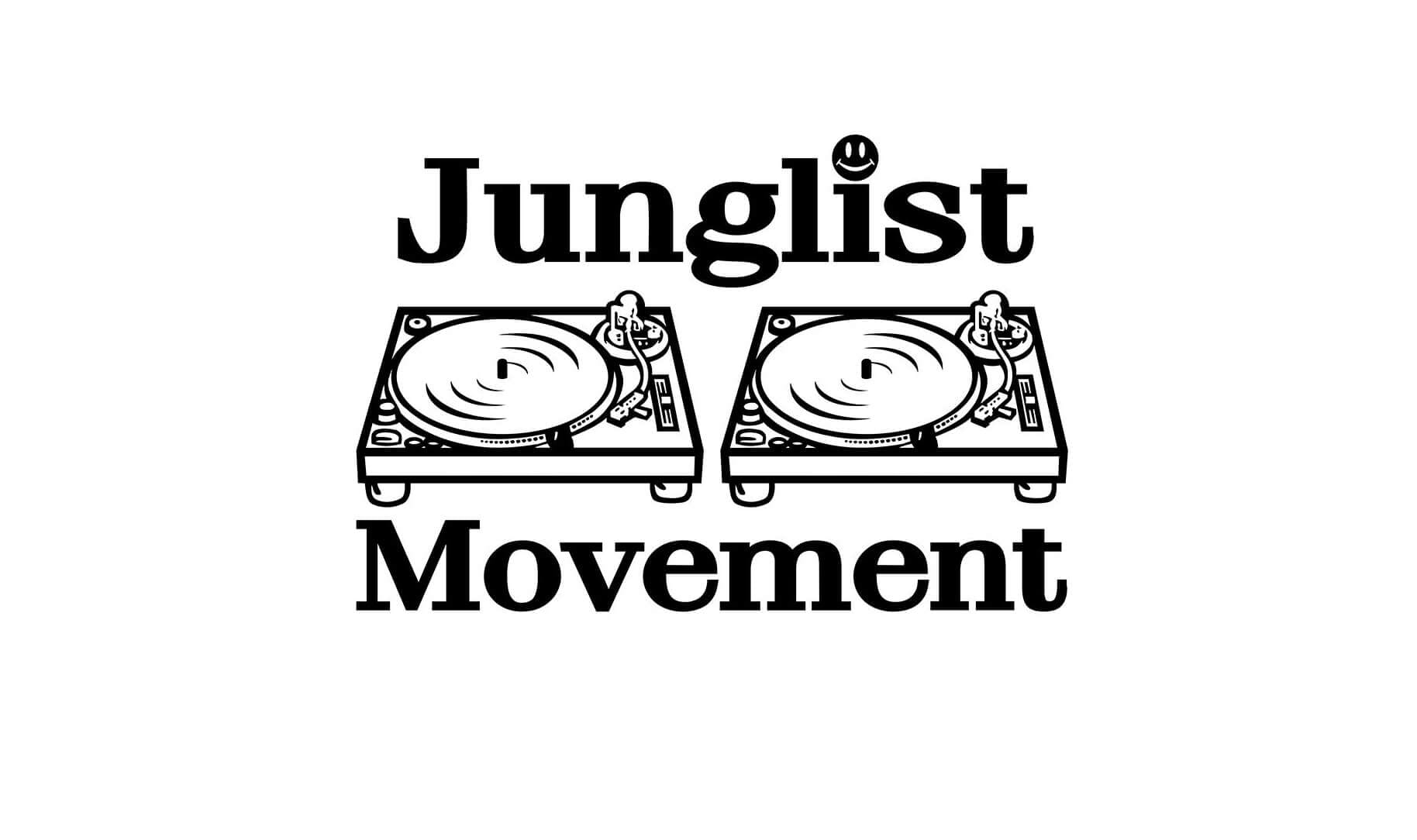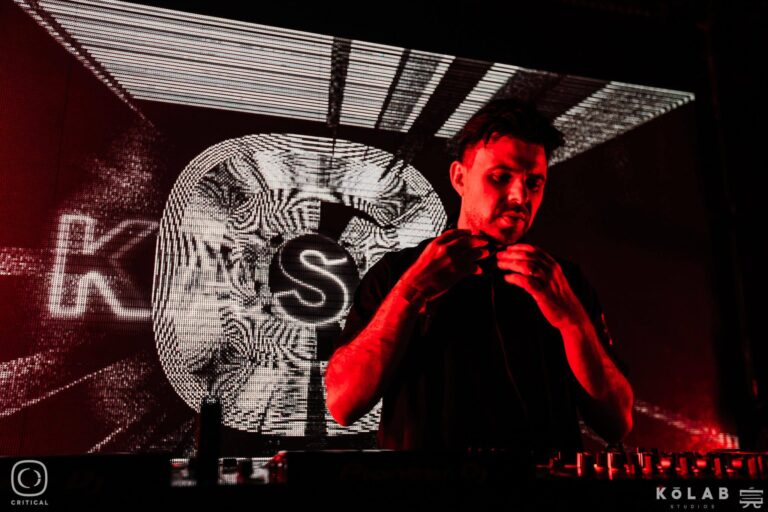No other logo represents this music and culture quite as ubiquitously or timelessly as that of the Junglist Movement brand.
It’s been a consistent mainstay on both dancefloors and raver wardrobes since the mid 90s when designer and founder Leke Adesoye printed his first run of T’s for his crew. His mission was simple; to create garments for the burgeoning jungle community. Founded in Leke’s years of hip hop culture, the clothes a nod for those who know and an alternative to the standard Versace/Moschino style in London or the bright hippie baggies in the raves at the time. The iconic Technics-inspired design hit the spot and its message has remained relevant and virulent ever since; pushing the jungle cause well beyond the confines of the genre. Fans of the brand range from Groove Armada to model Bee Philips via D Double E, Joel Dommett, Ed Sheeran and Ghostface Killah. And that’s before we even consider its presence on the cult clubbing movie Human Traffic.
In more recent times he’s designed unique drops with Hospital Records for last year’s Hospitality In The Park, he’s collaborated with the exercise phenomenon that is Flight Klub and has partnered with Human Traffic Live with a new collection exclusive to the forthcoming Lost Weekend event at Printworks in May.
Ahead of that, however, Leke will be taking over Fabric’s Room 2 on February 28 to celebrate the 20th anniversary of Junglist Movement and his main brand Aerosoul. Just like the movement he’s been immersed as an integral figure in since day one (he was a founding member of Mixrace, an experimental rave/rap act who went on to be signed by Moving Shadow) the line-up covers all bass bases with a line-up of Aerosoul and Jungle Movement endorsed artists: Makoto, Kenny Ken, DJ Ron, Bailey, Zero T, AI, Seba and MCs Verse, Moose and 2Shy.
There’s a lot to celebrate. Since that first Junglist Movement design, Leke, who is also a DJ himself, has developed a range of brands under his Aerosoul tree: Hip Hop Movement, BabySoul and Aerosoul Africa are all designed and developed by him and all celebrate the cultures they pay homage to with the same level of authenticity and passion as his flagship brand… The same level of authenticity and passion he’s had since day one.
Aligned with artists such as Degs, DJ Die, General Levy and Colette Warren, no brand is as entrenched in the foundations of this music and culture quite like Junglist Movement and no other aspect of the culture tells a story quite so personal as fashion.
Here’s how the genre’s longest standing, most ubiquitous and timeless logos came to be…
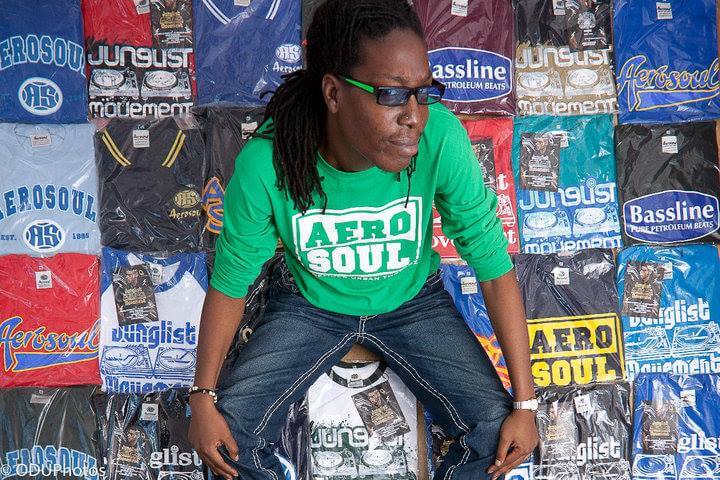
Let’s go right back to the start. You were in Mixrace with Paradox, right?
Yeah I guess that’s where it all started. I went to Harlow college in Essex. I was 17, Dev (Paradox) was 15, I was dating DJ Trax’s sister, we got together and formed our crew. I was rapping, Dev was rapping, Dave Trax on the decks. We were inspired by Hijack and London Posse. That’s the vibe we were on. That was the foundation. Spitting over breaks. It was very experimental done on a basic set up, recording on tape.
The original DIY spirit
It got more serious for them later of course but I didn’t see music as a career for me. My vision was design and creating. When I moved back to London and got a flat, my boys hung out here and we did the same thing we were doing in Essex, just partying all the time. Thunder & Joy, AWOL, Labyrinth, all that stuff. Touchdown pirate radio was down the road and we were on that a lot. We were just experiencing the lifestyle.
I have no doubt graffiti was in this mix, too?
Absolutely. That’s another foundation. Aersosoul is inspired by typography. The book Subway Art had a big influence on me. I grew up in boarding school from the age of about 7 till I was 16. I was pretty much by myself, very independent, people around me from different cultural upbringings. We were doing graffiti, skateboarding, breakdancing, BMX. We’d take our lino down to the Madison Jones club in Bournemouth and battle these guys who ended up being the massive crew Second To None. We’d bury them every time! Hip hop culture during the 80s was huge, so I spent my years soaking it all up. Then when I met Dev it all fell into place.
Was there a definitive moment for you when you knew fashion would be your role in the culture?
Definitely. I was raving a lot. I got my flat in London when I was 18 and the whole crew was 20 deep by then. Dev and Dave were doing beats all day, I was studying at London College Of Fashion. Then at night we’d be raving either in London or in Essex. It was an inspiring mix. The Versace, Moschino champagne vibe in London then ravers in countryside with baggy stuff, bright colours, all that. I was loving elements of both and wanted to bring the two together because I didn’t see anything for the culture. Something that represents who you are, that all our boys would resonate with and want to wear.
Threads for the crew!
I was influenced by Def Jam and hip hop culture and we didn’t have that here. We had jungle, this massive movement, but we didn’t have the fashion side to it. I wanted to design something that would represent us. Like a club that certain people know. I knew decks had to be part of the logo because that’s what I’d see every day in the studio, club, at home, radio station. Everywhere. I tweaked the Technics font and jungle was a dirty word at the time which was even better. I wanted something in your face and instantly recognisable. I knocked up a few in evening in college, gave some to my boys and we were flexing.
Were they instantly received well?
Yeah. They hit the right note with the right people. DJ Ron was one of the first who really helped me take the brand to where it needed to be. He was my mentor and very soon we had a lot of people representing the movement and clothing. It wasn’t long after that when I got the script for Human Traffic. The director had seen some of my samples, he was interested, the film went off and that was what really pushed the brand and design.
You had some legal wrangles with some of your other designs, didn’t you?
Junglist Movement was the first design. But yeah, other ones I had did attract bad attention. In the rave era there was a lot of piss-taking stuff. That was part of the culture. So I did Roots with the Boots logo and Needafix for Weetabix and Natural Born Players for NBA. Boots and Weetabix weren’t happy. They threatened to throw me in jail! I was young and naïve at the time. They got heavy. That’s why I changed the name from Outrage Clothing.
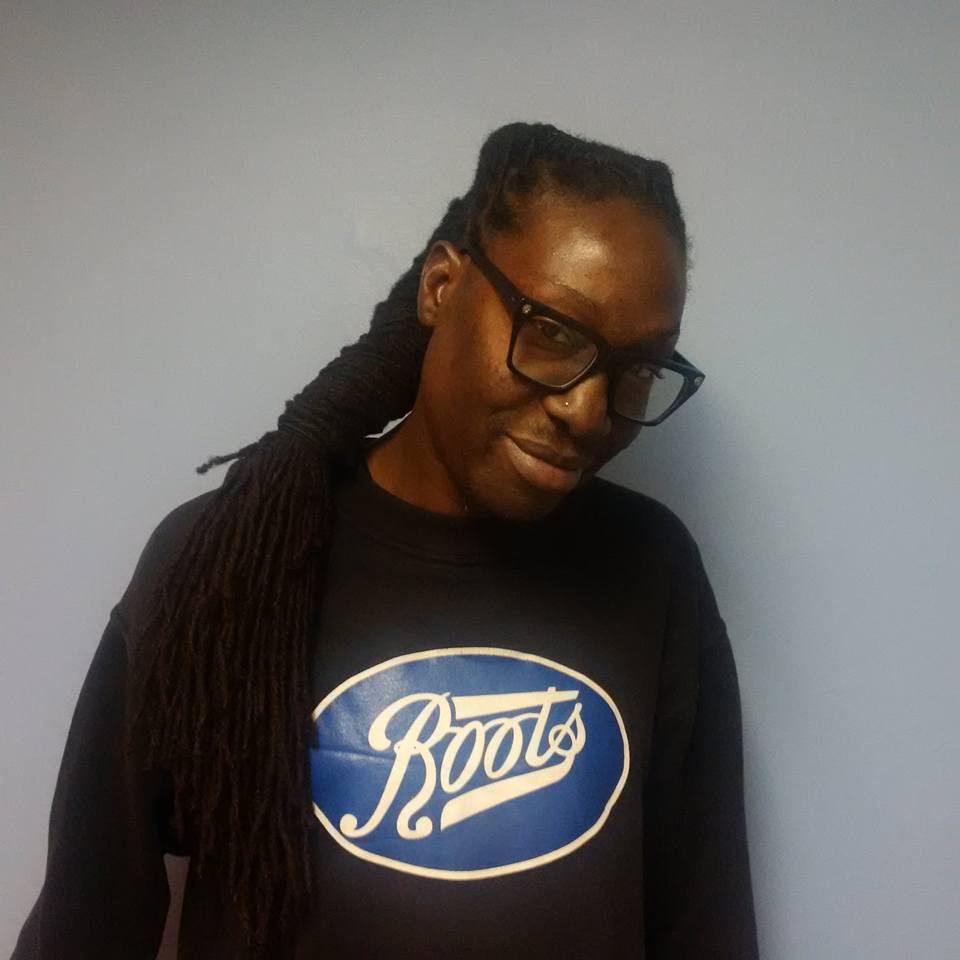
They were pre-meme memes in a way. Referential. Nicely anti-corporate.
That’s what rave was about. I learnt from it, though. If I can get that attention then what I’m doing is having an effect and I should take it seriously. So I redefined my brand as Aerosoul because – as you mentioned with the graffiti – that’s what everything was founded on for me. I bought the two together. It was everything that represented me; hip hop culture, graffiti, wordplay, the music, fashion.
It was a very personal brand…
Yeah it has to be. Fashion is very personal isn’t it? So I started creating more products around the Aerosoul brand. And when I was doing that Human Traffic came out and that took things up again.
Fashion is also a very broad church. It’s meant you’ve worked with people from so many industries. Film, sports, not just music…
Exactly. We push the music from a cultural point of view and play a big part in the movement. I do feel that gets overlooked a lot. I’ll give you an example; some very big artists have used my logo and own my brand in their content to get stripes, but not reached out to me and worked with me. That’s a culture vulture move. I might not be on the frontline but my work is out there and I’ve been here in the game for 20 years, just reach out to the originators and work with us positively.
I hear you. On the flip of that, when you do work with people this is much more than sending an artist a bunch of merch, right?
Absolutely. I don’t cut any corners with my products and brands, I go on in on it. So when I work with someone I’m creating a connection and relationship between our brands. It’s very tight, it’s a family. From the hip hop side I’ve been working with guys like Rodney P, Omar, Skitz and Ty. From the jungle side I started with Kenny Ken, Moose, Ron. They’ve been with me ever since. I’ve never rinsed it, I’ve kept it as a family which keeps on growing.
Collaborations are an important thing for you aren’t they?
Definitely. For me collaboration is about mutual respect, when you get that balance the product is going to be dope. All my collaborations come about because we love what each other are doing. Even with the artists who I sponsor, that’s a collaboration for me. It’s not just product placement, it’s like A&Ring. People I’ve sponsored early on are now massive. That’s the A&R side, being able to spot a talent and seeing it if fits in with your brand and whether they’re going to be around for the long game. I ask myself where they’re going to be in five years time or 10 years time and we grow together.
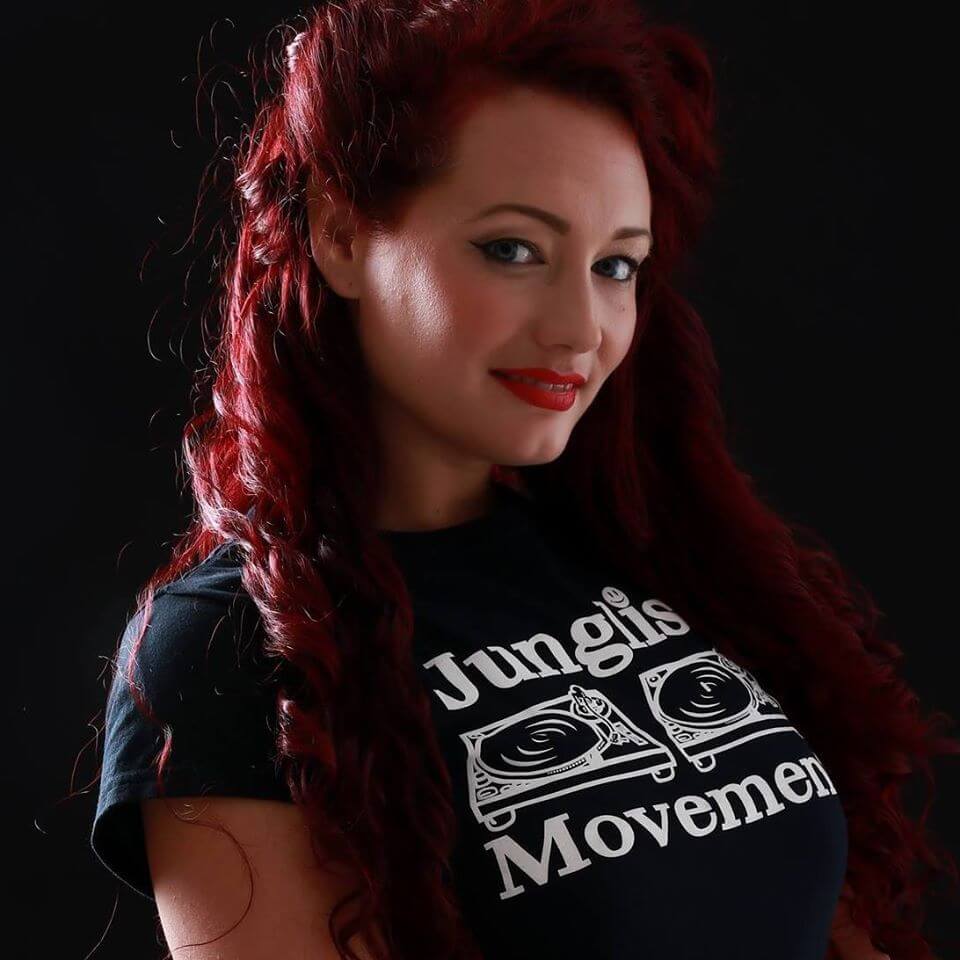
I think Ben Soundscape might be a good example there.
Perfect example. He’s family. I’ve been sponsoring him since he was 17 years old. Before Intrgue or any of that. I heard a tune of his on Defunked and went to Bristol for a meeting. Now Intrigue is the longest running night in Bristol. That’s a good example of us spotting someone who’s still going to be smashing and influential 10, 20 years later.
Speaking of 20 years, you’re about to celebrate 20 years of Aerosoul at Fabric…
Yes! We’re taking over room two at Fabric with Makoto, Kenny Ken, DJ Ron, Bailey, Zero T, AI, Seba with MCs Verse, Moose and 2Shy. We’ve got the jungle and drum & bass. A celebration of everything. The full spectrum of the music and the full spectrum of what I’ve been about. We’re going to shut down London that night. It’s brilliant – it’s time to celebrate the full culture.
You’re also involved with the Human Traffic Lost Weekend event aren’t you?
It’s a really interesting event which also marks 20 years of the film. It’s happening in Printworks, it’s a four day event with different DJs, acts and all kinds of things like pop up shops, scenes from the film set up like Koop’s shop and different areas dedicated to the movie. So I’m involved in that and doing the merch for it.
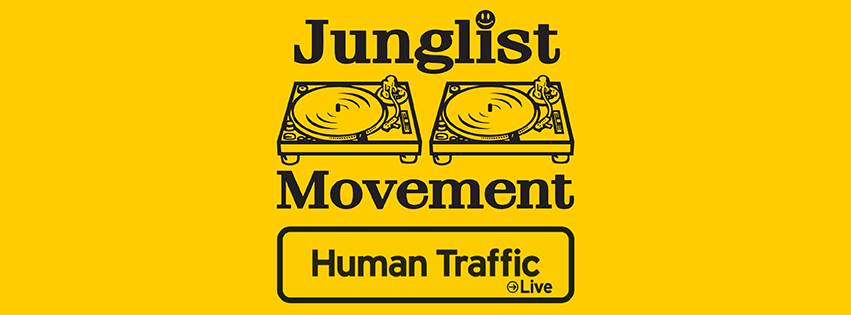
You just did a collab with Hospital for Hospitality In The Park, too. Do you have any other big collabs you can reveal for 2020?
I want to push Aerosoul Africa. That’s part of who I am and my identity. I want to focus more on that as a brand. Afrobeat is huge and Africa’s rich culture needs to be celebrated with products everyone would be proud to wear. I’m working with a really inspiring artist from Tanzania and it’s a big focus for me. Beyond that I’m just making sure I’m making the best products and designs I can and bringing everything together. Aerosoul, Junglist Movement, Hip Hop Movement, Babysoul, Soulero Sista and Aersosoul Africa. Each one is its own brand but all under the main Aerosoul umbrella. We’ve had some great attention recently so it’s about capitalising on that and bringing everything together in-house.
Joining dots and bringing people together…
Totally. The Hospital one was a big thing for me. They push things forward, they do things properly, I respect them highly and have always had a good relationship with them. There’s that mutual admiration there that I mentioned before. And what I love about the scene is that there’s people who’ve been doing this for a lifestyle, it’s not an age limit, you’ve still got OGs absolutely ruling it. Look at Fab and Groove. Still kings after 30 years. Or in fashion you shave 80 year old designers. Look at Dapper Dan. He’s just hooked up with Gucci and he’s in his 70s. He’s a huge inspiration to me and was jacking logos years before I was. Now he’s working in a partnership with Gucci. Who’d have thought that? He’s getting his props now.
That’s why I’m working the way I do and as hard as I do. It would be nice to have props sooner than when I’m 70. I’ve had sickle cell anemia since I was born and have to have blood transfusions every month. It’s got worse and has led to arthritis, gout and kidney failure, it’s very complicated.
Wow, sorry to hear
It’s life for me. I was born with it, I’ll die with it. So I work hard and make sure my legacy is here and my work is the best it can be and is rated and respected and recognised. And that’s through meaningful collaborations, respect and being true to myself and true to the culture. That’s why I’m known for real talk. Life isn’t all clubs and champagne and balling. Some days I’m wired up to a hospital bed, my phone is locked off and I have to deal with life. I’m not alone. Many people have the same condition and that’s something I want to raise awareness about.
I don’t need any sympathy, but I do need to say that we need more black blood donors. In my area one in six kids in the African and Caribbean community area suffers from it, yet it doesn’t get anywhere near as much focus or attention as other diseases because it’s black-related illness. So if you can donate blood, please do. But for me personally, 2020 is all about Aerosoul, Junglist Movement, Hip Hop Movement, Babysoul, Soulero Sista and Aerosoul Africa. Just getting my work out there and telling my story. My designs are some of the most bootlegged out there and I want people to know they should only come to the source for this. We’re not making millions, we’re not balling, we’re just keeping the culture moving in the right direction. That’s what we do….
Visit Aerosoul : Visit Junglist Movement
Follow Aerosoul : Follow Junglist Movement
